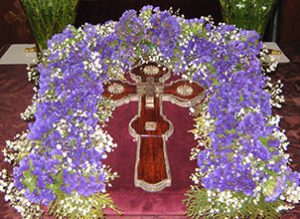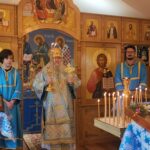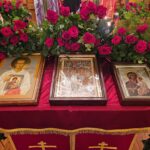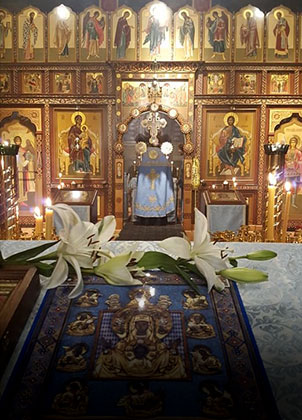Translated by Seraphim Larin
More than 15 years of our “refugee” church existence has passed. Let us recall the calamities that befell us in these past years! Even before the signing of the “Act of Canonical Communion” with the Moscow Patriarchate, we were already divided into two warring groups, headed by such Bishops that after ten years of ordeals, we were left with no alternative than the need to flee from them.
In order to understand our mistakes, it is beneficial to turn to events over the past 15 years.
Over the past decades, the Russian Church Abroad was distinctive with Her monolithic steadfastness. It wasn’t characteristic for Her members to organise divisions because of any type of disagreement. How can it be explained that those who did not accept the unification with the MP in 2007 found themselves divided into microscopic groups – ROCA “fragments”?
Over a sequence of years, ROCA enjoyed a conviction in its exclusiveness since at that time ROCA firmly adhered to pure Orthodoxy while the other Churches, in one way or another, deviated from it. Thus, in the minds of Her parishioners, standing in truth equated to belonging to ROCA. Gradually, the concept of the one true jurisdiction was born, to which one must belong in order to be among those who are being saved.
The misconception here lies in that the understanding of the Church as such is being substituted with the understanding of jurisdiction, i.e. the administrative church structure.
When, after 2007, these parishioners found themselves in different Synods, the comprehension of true jurisdiction was carried over to their own group. Hence the surprising phenomenon that the members of the one ROCA, began to regard only themselves as belonging to the Church while their fellow brothers and sisters who found themselves in another Church jurisdiction, were declared schismatics and renegades.
However, apart from the spiritual-psychological reasons, there are without a doubt, external causes for our fragmentation. There is a noticeable presence of an evil mind, intent on fostering a division among us into hostile groups and supporting this animosity.
Experience has shown that with the presence of a disposition toward unification on the part of the primates of the Church groups, there is no opposition from those beneath, and all preconceptions are quickly overcome. From this, it can be seen that the true reason for our division is the lack of good will toward unification among the First Hierarchs of the ROCA groups. These Hierarchs brazenly exploit the above-mentioned parishioners’ preconception, proclaiming that their group is solely grace-filled and salvific.
It is an undeniable fact that the unification of ROCA with the Moscow Patriarchate was the result of many years of endeavour by Russian special services. The KGB has laboured over decades to achieve this goal. There was infiltration of the ROCA parishes: agitation: recruitment of supporters, and even physical liquidation of influential church leaders that were opposed to the unification with MP.
The last phase of this special operation took about 10 years, and the signal of its beginning was the open meeting of Archbishop Mark with Patriarch Alexis in December 1996. In all likelihood, the decision on unification was adopted in the lobbies of the New York Synod, after the meeting with President Putin on the 25th of September 2003. The subsequent “unification process” was nothing but a farce, and on the 17th of May 2007, in the Cathedral of Christ the Saviour, Metropolitan Laurus signed the “Act of Canonical Communion” with the MP.
Why was it so important for the KGB to have ROCA under its influence?
From the very beginning, the KGB’s mission was to establish an ideological control over the Russian émigré community, a mission that saw a significant success by the Chekists. It was noted more than once that the Russian émigrés have not created numerous public organisations, while the Russian people often treat the existing Russian organisations with distrust. For the Russian émigré community it was the church parishes that always served as centres of attraction.
That’s why to take ROCA under its control meant the opportunity for the KGB to direct the social life of the Russian community. In order to evaluate the KGB successes in this matter, it’s sufficient to state that after joining the MP, the ROCA parishes became centres of propaganda for the Russian regime.
In the years preceding the unification with MP, the number of opponents to this unification among the ROCA clergy were approximately equal to those who supported this (doubtless, the KGB agents were pleasantly surprised when it appeared that after unification, the majority of these opponents to unification drifted with the tide straight into MP – as though nothing happened).
It’s impossible to imagine that the KGB didn’t prepare any plan of action with regard to those priests and lay people who were in opposition to the MP. After all, if after the signing of the “Act” a considerable group of opponents of the unification was formed, which included well-known church leaders, the success of the unification would have been greatly diminished. This could not be allowed to happen.
Characteristically that in the period before unification, Metropolitan Laurus freely gave his blessing for going over to the Greek Old Calendarist Synods. And this is not difficult to understand. The Greek True-Orthodox Synods are not perceived as direct opposition to the MP. To the creators of unification, the loss of even a significant part of parishioners didn’t pose any threat – it was even quite the opposite. The more of the old émigrés left, the quicker their replacements from Russia, brought up in the MP, filled their places. That’s why the best variant to the creators of unification was for their opponents to disperse among the Greek Synods.
In their battle against the Church, the KGB followed two principles: 1. Divide and conquer. 2. If you cannot destroy them – lead them. As an example, these two approaches can specifically be seen in the creation of the “obedient” Moscow Patriarchate. In accord with Trotsky’s plan, the primary goal of the formation of the Sergianist false church was to split the Russian Church – which proved to be successful. At the same time, the Chekists received an opportunity to control the Church through their agents among the Episcopate.
But let’s return to the question of how it could happen that in 2007 the opponents of the unification were immediately split into two warring groups. Did these ROCA parishioners and clergy have any differences or disputes? Completely no. If we suppose that this was organised by the KGB, then everything becomes quite clear, and all the pieces of the puzzle fall into place.
Some might say that this is nothing but an assumption. Of course. But it’s necessary to understand that by its very nature, the KGB is a conspiratorial organisation and consequently, there is nothing left but to make assumptions. On the other hand, if we were to exclude the KGB from this scenario, we would not be capable to understand anything from these events.
We are not asserting anything but only analysing that which has occurred.
The KGB could not allow the formation of an alternative ROCA. To prevent this from happening, it was necessary to divide the opponents of unification, to compromise them, to plant the KGB agents in their midst and take them under control. This was all accomplished quite easily and extremely successfully.
But let us examine these events in order.
The final decision for the unification with the MP was made by the Synod in New York on the 6th of September 2006, who approved and confirmed the “Act of Canonical Communion”. All that remained was agreement on some details and the time of signing of the “Act”, etc. There was nothing left for the unification opponents but to wait for the inevitable.
It was in this atmosphere that Archbishop Tikhon of Omsk (Pasechnik), chairman of the Synod of the Russian True Orthodox Church (RTOC), published several appeals in which he urged the unification opponents not to wait for the signing of the “Act” in May 2007, but to come over temporarily under his Omophorion (jurisdiction). Archbishop promised his help in consecrating new Bishops for the re-establishing the Hierarchy and administrative structure of ROCA. He emphasised that he was not trying to spread his jurisdiction outside of Russia, and when the new Bishops had been consecrated for ROCA, he will remove his authority.
The RTOC Synod wrote on the 24th Nov. 2006: “Our view in the proposed path toward the re-establishment the ROCA administration is such: we are not creating our structure abroad, our common aim with the clergy abroad is to preserve the canonical ROCA, to help our sister Church Abroad in a difficult period of Her life… After the re-establishment of the ROCA Bishops’ Synod, the Russian Church will present two equal parts – RTOC and ROCA, under different church administrations in Eucharistic communion and spiritual unity”.
Prior to the re-establishment of the organs of church administration in ROCA, the parishes abroad that have temporarily entered under RTOC Omophorion, were to be subordinate to the chairman of the RTOC Synod, Archbishop Tikhon.
Alas, events over the subsequent years showed that it was all a deception. Archbishop Tikhon, immediately began to build a diocese abroad “for himself” and strengthen his influence, leaning on those parishioners that were loyal to him. And after a couple of years, he openly changed his rhetoric and began to affirm that as the ROCA is part of the Russian Church, She must forever remain under the Omophorion of the “mother-church” i.e., RTOC. When after 10 years there began a spontaneous mass exodus from Archbishop Tikhon’s jurisdiction, on his part, canonical bans and lawsuits for parish property followed.
To the KGB, here was a simple calculation: some, but of course not all the opponents to unification will respond to Archbishop Tikhon’s invitation, while part of them will refuse to undertake any actions and remain with Metropolitan Laurus up to the day of signing of the “Act” on 17th May. Thus, automatically there are two groups.
After 17th of May 2007, those who didn’t join RTOC found themselves under the Omophorion of Agafangel (Pashkovsky), Bishop of Odessa, the only Bishop of Metropolitan Laurus’ Synod that didn’t agree to join the MP (if we discounted the elderly and ailing Bishop Daniel (Alexandrov)).
It’s important to note that nobody invited Bishop Agafangel and appointed him to this position. As the sole remaining Bishop, he naturally placed himself at the head of this church group. Thus, Archbishop Tikhon himself offered his help, while Bishop Agafangel assumed authority as the only remaining choice. Apart from these two options, there was no other alternative to the opponents of the unification except joining one of the Greek Old Calendarist Synods, which many did, thereby further weakening ROCA.
And how did Bishop Agafangel take advantage of his position? He began immediately to create a Synod in which his adherents were assured of a majority of votes. To this end, he performed several episcopal consecrations in the shortest period and without any need ordaining unknown persons to the bishops for non-existent dioceses. He even accepted two Bishops from the Sekach group, whose line of hierarchy is positively known to lack Apostolic Succession, since it originates from an impostor and agent of GPU Mikhail Pozdeev.
Bishop Agafangel set up a fictitious Synod whose real purpose was to keep us under control.
After a year, in November 2008, Bishop Agafangel organised a council in New York, which appeared more like a special operation than a Church Council, where he was elevated to the rank of Metropolitan.
From the very first days, these two first hierarchs, Archbishop Tikhon and Bishop Agafangel began a sharp polemic on the Internet with one another, calling each other as being uncanonical, without grace, etc. This polemic was seized upon by their adherents who expressed the same accusations, but in an extremely rude, unacceptably abusive tone. Parallel to this, both Hierarchs were issuing appeals, inviting one another to enter into communion, but with such conditions that were knowingly unacceptable to the other side.
Thus, the division, that happened due solely to circumstances, deepened more and more and was gravitating toward a fundamental, canonical level, while acquiring an extremely hostile nature.
At the same time, this ugly Internet “squabbling” was compromising our Church and pushing away parishioners from Her.
From what was said above, it shouldn’t follow without fail that we regard both Hierarchs as staff members of the KGB. But it shouldn’t be forgotten that the KGB is the major moving force of the Russian regime controlling all spheres of public life in Russia. The Russian citizens appear as potential hostages of this regime. It should also be mentioned that the FSB (KGB) up to recent times, felt quite comfortable in Ukraine.
Very wise was the decision of the Council in Mountain View in January 2017 that the District Abroad, while maintaining Eucharistic communion with the Russian District, must at the same time maintain its full administrative independence.
Reflecting on the events of those years, one is amazed at the incomprehensible naivety and trust of the ROCA parishioners. How could they entrust the organisation of the Church to completely unknown Bishops? For example, could one imagine at a parish council the parishioners choosing an individual as treasurer that was completely unknown to them? In our instance, unknown bishops were given the powers of the First Hierarchs: they were given a carte-blanch to organise the life of our Church!
The spiritual and moral level of the episcopate of the Church Abroad has always been very high. Hence, it was customary for the ROCA flock to revere their bishops. This is probably the reason why we became easy prey. On the other hand, let us remember what situation we were in: we were betrayed by our Bishops, lost and divided. Planted agents commixed among us and their voices were heard above all others. It’s easy to be wise in hindsight.
Going over under the Omophorion of Archbishop Tikhon and Metropolitan Agafangel was a trap, but it took 10 years for the clergy and parishioners to realise that. I remember the words that greeted me at my first meeting with late Fr. Michael Konstantinoff: “Vladyka, we were caught in a trap”.
We sensed we were tricked. We felt that these Bishops were not what they made out to be – that they are fraudsters. They were of an alien spirit, MP spirit, although camouflaged in a True-Orthodox rhetoric. This was expressed admirably by Bishop Stefan (Sabelnik) when addressing the RTOC Bishops: “You cannot be Bishops of the True Church because you lie”.
After 10 years of ordeal under their authority, we finally broke free to freedom as though from the clutches of robbers, although at the price of losing people, parishes and property. We broke out to freedom with the label of uncanonical schismatics, because there was no other way to escape this canonical trap if we were to conform to the letter of the canons.
Independent of one another and nearly simultaneously, a large section of clergy and laity departed from Metropolitan Agafangel’s and Archbishop Tikhon’s authority. A few months later, the Eucharistic communion was formed between Archbishop Andronik and Bishop Stefan, and following this in September 2017, the District Abroad was formed that contained both groups.
Now, at least let us try to be more circumspect so as not to repeat past mistakes. Above all else, we must value the freedom of our Church.
+Bishop Andrei









